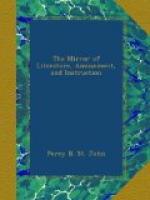ST. PANCRAS (OLD) CHURCH.
[Illustration: St. Pancras (old) church.]
This humble village fane is situated to the north of London, somewhat more than a mile from Holborn Bars. Persons unacquainted with the site, may hitherto have considered it as part and parcel of this vast metropolis: but, lo! here it stands amidst much of its primitive, peaceful rusticity.
Pancras is still, by courtesy, called a village, though its charms may be of the rus-in-urbe description. It derives its name from the saint to whom the church is dedicated:[1] it was called St. Pancras when the Survey of Domesday was taken. The parish is of great extent. Mr. Lysons states it at 2,700 acres of land, including the site of buildings. It is bounded on the north by Islington, Hornsey, and Finchley; and on the west by Hampstead and Marybone. On the south it meets the parishes of St. Giles’s in the Fields, St. George the Martyr, St. George, Bloomsbury, and St. Andrew’s, Holborn.[2] On the east it is bounded by St. James’s, Clerkenwell. Kentish Town, part of Highgate, Camden Town, and Somer’s Town,[3] are comprised within this parish as hamlets. Mr. Lysons supposes it to have included the prebendal manor of Kentish Town,[4] or Cantelows, which now constitutes a stall in St. Paul’s Cathedral. Among the prebendaries have been men eminent for their learning and piety: as Lancelot Andrews, bishop of Winchester, Dr. Sherlock, Archdeacon Paley, and the Rev. William Beloe, B.D. well known by his translation of Herodotus.
[1] St. Pancras was a young
Phrygian nobleman, who suffered
death under the Emperor Dioclesian,
for his zealous adherence to
the Christian faith.
[2] Lysons’s Environs, 4to. vol. ii. part ii.
[3] The parish extends in
this direction to the foot of Gray’s
Inn Lane, and includes part
of a house in Queen’s Square.
[4] Anciently Kentistonne,
where William Bruges, Garter King at
Arms in the reign of Henry
V. had a country-house, at which he
entertained the emperor Sigismund.
It would occupy too much space to detail the progressive increase of this district. When a visitation of the church was made in the year 1251, there were only forty houses in the parish. The desolate situation of the village in the latter part of the sixteenth century is emphatically described by Norden, in his Speculum Britanniae. After noticing the solitary condition of the church, he says, “yet about this structure have bin manie buildings now decaied, leaving poore Pancras without companie or comfort.” In some manuscription additions to his work, the same writer has the following observations:—“Although this place be, as it were, forsaken of all; and true men seldom frequent the same, but upon devyne occasions; yet it is visyted by thieves, who assemble there not to pray, but to wait for praye; and manie fell into their handes, clothed, that are glad when they are escaped naked. Walk not there too late.” Newcourt, whose work was published in 1700, says that houses had been built near the church. The first important increase of the parish took place in the neighbourhood of Tottenham Court Road.




